Newcastle Bus Stations - Haymarket & Eldon Square
Newcastle Bus Stations - Part Three
Not seen this gallery from the beginning, click here
Haymarket & Eldon Square
Haymarket is the only one of the original three still in use, most services were operated by United, although Newcastle Corporation Transport had two, the NGT, Tynemouth & District and Wakefields Motors subsidiaries 'Percy Main' had three. The service 5, to Darras Hall Ponteland via the Airport was operated by NCT, and the 11 to Tynemouth, was a shared with P/M. In addition to the 11, P/M also operated the 3, to Cullercoats, and the 5 'different route' to Whitley Bay. The longer United routes to Edinburgh and Glasgow were shared with SMT.
In the 60's, the commercial centre of Newcastle could rival any City in the world for its architectural beauty, to be fair, it wasn't all like that and some parts were way past their best. Newcastle City Council set out on a programme of destruction, sorry, 'redevelopment' in the process many historical buildings were sacrificed; ironically, many of the new replacement buildings have since been demolished. The two main protagonists of the scheme were architect John Poulson, and Councillor 'T' Dan Smith, who glorified in the somewhat arrogant name of Mr Newcastle. As things transpired, their motives were greed and corruption. Through the Courts, Her Majesty subsequently rewarded their ceaseless efforts to the cause when she extended an invitation to them to become her guests in one of her institutions. Their plans included the Haymarket bus station, work also started on a new bus station in the new nearby Eldon Square development. Whilst construction work was going on, P/M services 3 & 5 along with the joint NCT service 11, and the United service 8, were moved from Haymarket to a temporary location in St Marys Place, which was literally just round the corner, long distance and express services were moved from Haymarket to the United depot at Gallowgate. Once the first stage of Eldon Square was complete, Ok moved to a start point, in Market Street, which had previously been the site of the Green Market. The services which had bean temporally housed in St Marys place, and many services that had previously used Marlborough Crescent started to terminate at the Eldon Square Concourse, the same thing happened with some services from Worswick Street, and the two stations went into terminal decline. The Centre for Life complex has replaced Marlborough Crescent, and Worswick Street is practically derelict.
Haymarket has since been rebuilt 'again' and Eldon Square has also been updated, the completely covered bus station was under the shops, it was a dark, dinghy and rather threatening place, which was poorly ventilated, so fumes were a constant problem. As part of the updated complex, it has now been converted into retail units. Gallowgate Coach Station was an ideal central location, it was directly opposite the Metro, with its links to the main line rail network, it had a taxi rank, and was literally two minuets walk from Eldon Square and the Haymarket bus stations. It too has fallen victim to the developers, and has been replaced by the Boulevard Coach Station, which with the best will in the world can only be described as an afterthought. It must be very off putting for any strangers arriving in the City by coach, especially in winter months when it's dark by about 4.30. After sometimes a very long journey, they suddenly find that they've been dumped in a not very pleasant part of the City, which is nowhere near anywhere. 'Welcome to Newcastle'.
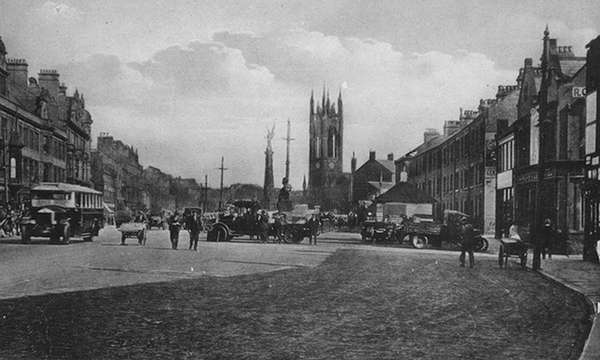
Haymarket prior to the bus station being built. The monument at the end is the South African 'Boar War' Memorial.
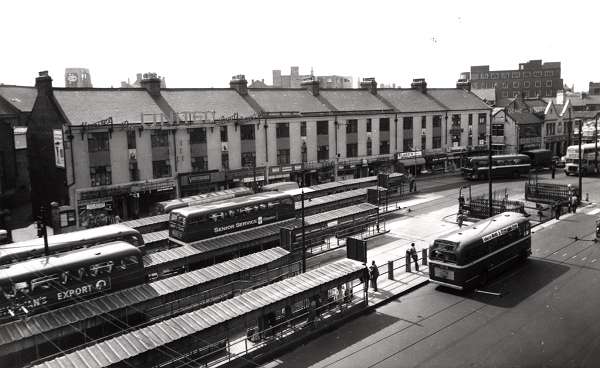
The trolleybus wires date the photo as pre 1966, the United LS at the bottom of the photo is heading west along Percy Street towards the unload and layover area. The two sets of railings to its F/N/S corner were the underground public conveniences. Haymarket was an extremely busy place with several services using each of the platforms, vehicles were not allowed to enter the stands until five minutes prior to departure, at peak times and Saturdays, the P/M service 5 and United 8 left from the stand by the layover area. Low bridge or single deck buses were required for the service 5 to Darras Hall, in all probability the NCT low bridge PRV bodied AEC Regent V, to the right of the photo is heading for the service 5 departure point, which was the bottom stand in the picture. However, if the need arose, these buses were on occasion used on other services, so it could be on the service 11. Behind, you can see what the layover area; the large building to its right was the Farmers Rest public house. In front of the Regent is an NGT D/P, it will be on one of their express services, and is heading towards the top stand where all long distance and express routes departed from. This included the United twice-daily Tyne, Tees, Thames service. Haymarket was a very confusing place for strangers, as I have said the NCT service 5 departed from the bottom stand, this was also the departure point for the United service 11 to Seaton Sluice. On the second stand from the bottom is a P/M PDR1/1 Atlantean on the service 11 to Tynemouth. On the next stand up is a low bridge United KW, on service 17 to Whitley Bay via Forrest Hall, the Roe bodied Atlantean behind it is another P/M vehicle on the service 5 to Whitley Bay. No, you have not read that wrong, departing from the first three stands from the bottom, you had two service fives, and two elevens, all going to different places.
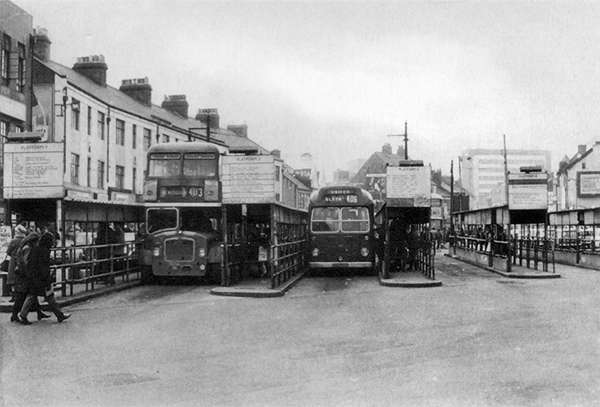
The three digit route numbers date this as post NBC. Built in a time when buses were 7'6" wide, Haymarket was a tight squeeze for wider vehicles, and mirrors were a frequent casualty, at the rear is a NCT Atlantean lining up to go onto the stand for the service 11, this is the empty stand to the right of the LS as we look at it.
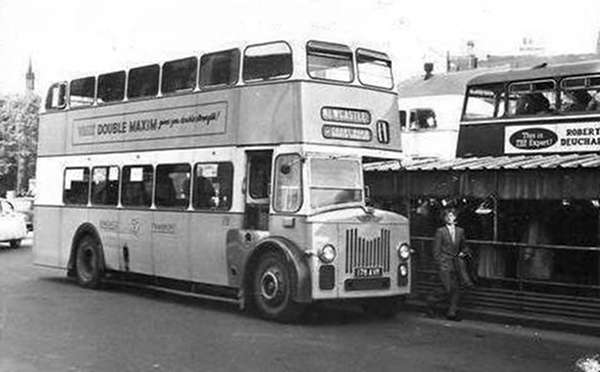
An H40/32R Weymann bodied Tin front Leyland PD3/1 of NCT, one of 10 delivered to NCT in 1957; 177 to 186 AVK. The route number is 11, but that would also be the number on the United KW loading up on the stand next to it. I told you it was a confusing place.
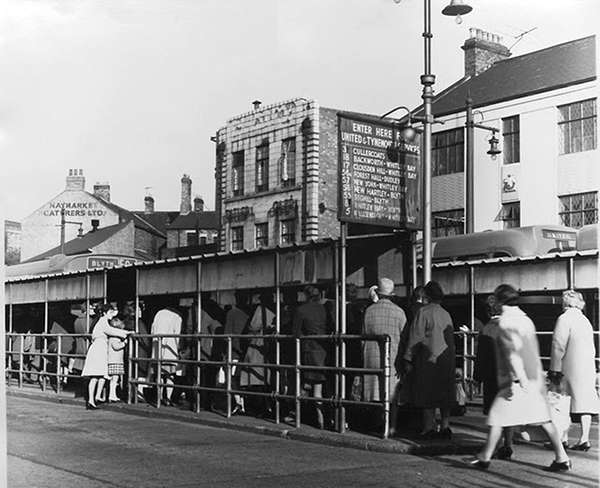
A typical day at the Haymarket.
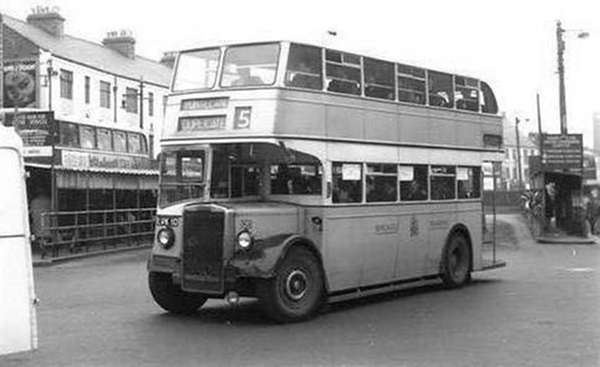
L27/26R all Leyland PD2/1. One of six low bridge Titans delivered in 1949; LVK 6/11. They were the second part of quite a large number the type delivered to NCT in 1948/9, the remainder were H30/26R versions. The 1948 vehicles were delivered in blue, but half way through completion of the order the decision was made to standardise the whole fleet in the trolleybus livery, so this would have been one of the first of the motor bus fleet in yellow. Its original fleet number was 10, but the arrival of the Atlantean's saw many vehicles renumbered, and this one became 359.
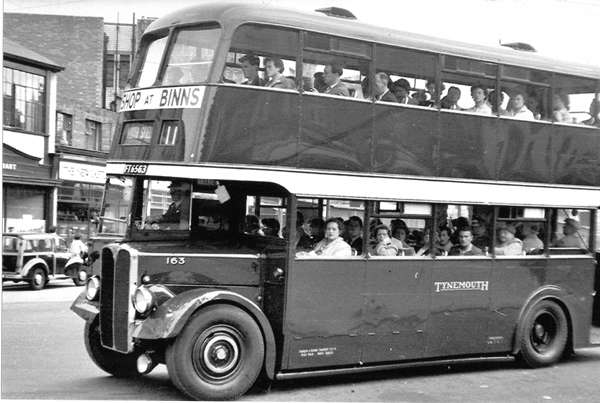
A P/M H30/26R Northern Coachbuilders AEC Regent III from 1949, is departing on the service 11 on short running to North Shields and loaded to the gunnels. The T&D services 3&5, the NCT/T&D 11 and the United 8, all left Newcastle towards the Coast. For the first nine miles, they all followed the same route along the A1058, until they went their separate ways from Billy Mill onwards. Between them, up to that point they had a headway of about five minutes, at peak time and Saturdays, duplicates brought this down to about three, most of them full.
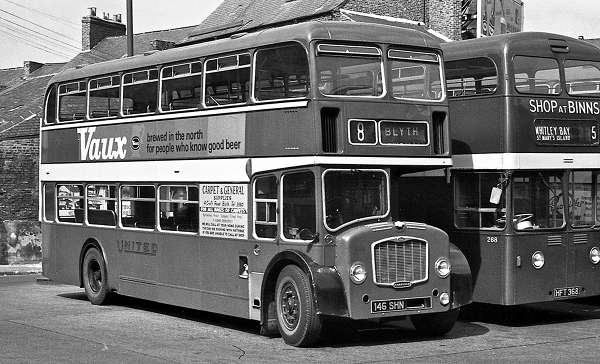
Standing alongside each other in the layover area, are 164 SHN; a Jesmond based United H38/32F Bristol FLF6B from 1964, and HFT 368, a P/M H44/35F Weymann bodied CRG6LX Daimler Fleetline from 1963. The buildings in the background 'long since gone' were on Percy Street.
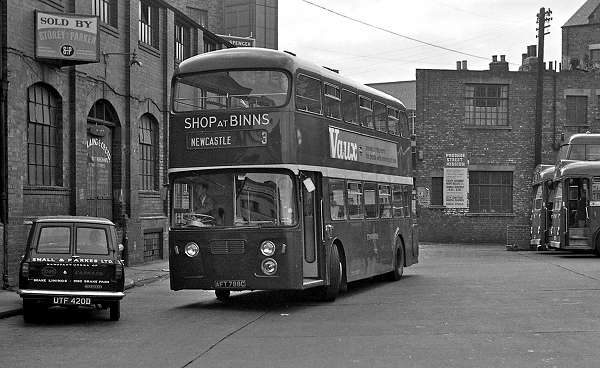
Reverse parking into a spot next to the two United LS's, is AFT 788C, a P/M H43/32F Alexander bodied CRG6LX Daimler Fleetline from 1965. Just visible behind the two LS's is the front of CWB 987, a 1936 Leyland TD4, numbered MC2 in the United fleet; MC being 'mobile canteen' in truth it only moved once a year when it went for overhaul, it has been featured before on this site. These days the location is part of M&S.
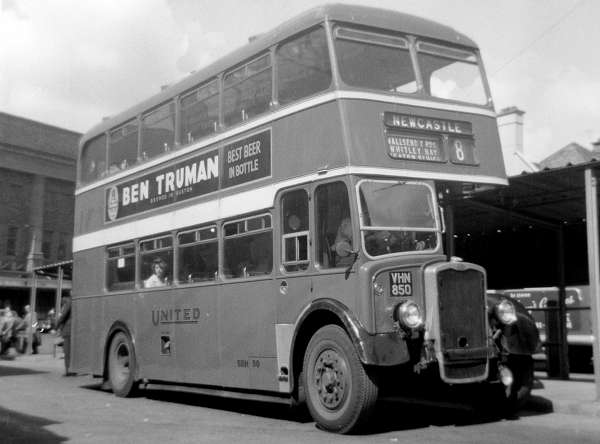
Standing at the discharge area of Haymarket is VHN 850; Bus list on the web has this as a 1954, KSW6B. However, the body is described as L27/28R, clearly that is not the case, so, is this a simple error, or was the body swapped at some stage? I'm am by no means an expert on the United fleet, but in the Newcastle area high bridge versions of the type were less common than low bridge. Taking up a previous point, at peak times and Saturdays, this stand was used as the departure point for the United service 8 and T&D service 5.
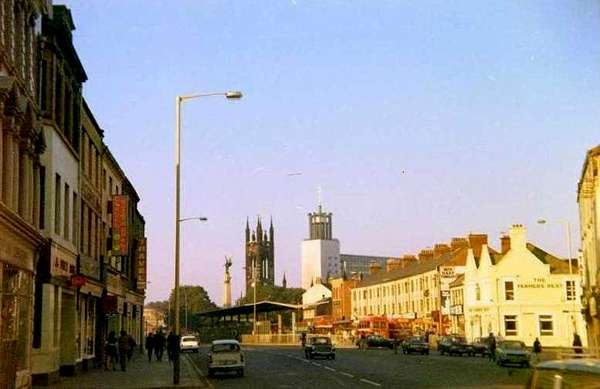
Haymarket rebuild, first attempt 1970's.
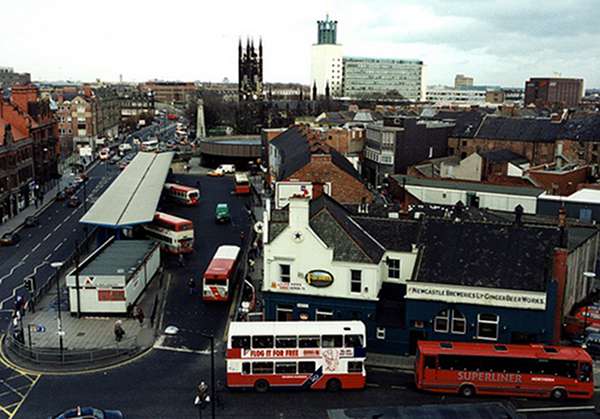
Looking down from NCP multi story car park.
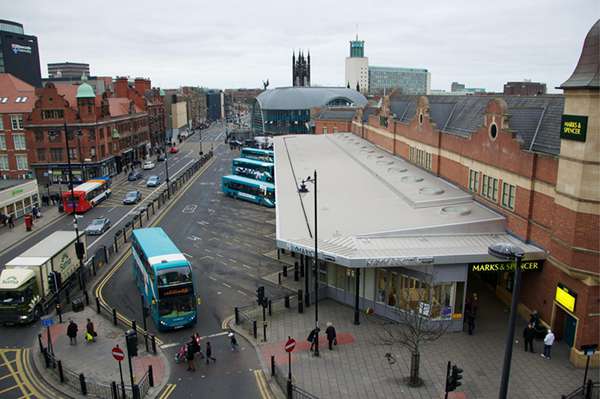
Haymarket as it is now, the top of the South African War Memorial is just visible above what is now the Haymarket Metro Station.
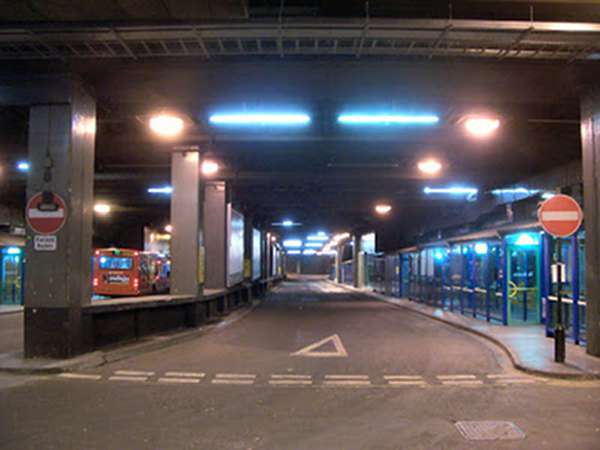
The first covered Eldon Square bus station. Photograph courtesy of Newcastle Photos Blogspot
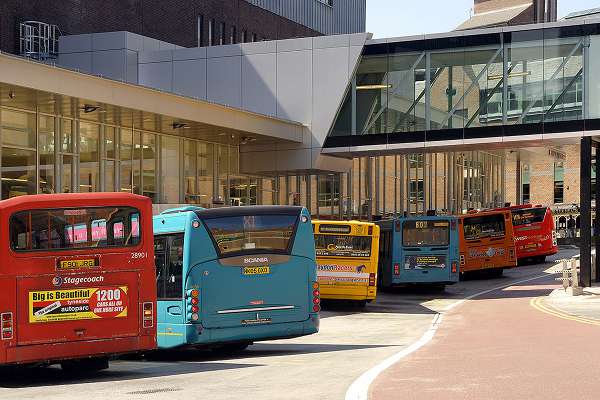
Present day Eldon Square.
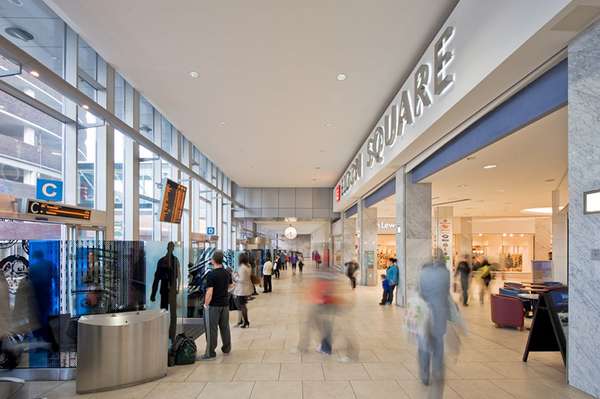
Eldon Square waiting area.
The old bus stations were open and offered little or no protection from the elements, Haymarket, and Marlborough Crescent had been described as resembling cattle markets, however, they were in my opinion much safer than their modern day replacements. Today's passengers are separated from moving vehicles and protected from the elements in warm bright clean buildings; Apart from the last six months, my spell at Percy Main was spent driving dual crew buses, if a vehicle was reversing unattended or with passengers on board 'except in emergencies' the crew were liable to disciplinary action. OPO routes had designated turning circles where no reversing was involved. The old bus stations only allowed vehicles to go in one direction, forwards, whereas these days, fully loaded OPO vehicles have to reverse off the stand. How I wonder, how does that fit into today's risk assessment, health and safety obsessed society? am I being cynical, or is this a case of profit and least cost outweighing everything else? The new Eldon Square bus station has won an award for its design, but so did the hideous 70's monstrosity it replaced. Things do go wrong and minor knocks and scrapes are not uncommon, however, to be fair 'to date' no major incidents have occurred so far, but I suspect that it's a matter of when, not if.
Ronnie Hoye
09/2014
20/09/14 - 06:03
Many thanks to Ronnie Hoye for his series on Newcastle Bus Stations. I was not familiar with any of them, but I loved the scope of his coverage of both buses and facilities, or lack thereof. As he points out, we may have modern facilities now in some cases, but the inherent dangers of the reversing out designs current today seem strange in our health and safety culture. In the south, Southdown's Chichester bus station (c.1955) was always a reverse out design (at right angles to the boarding pavement), and continues to be so today under Stagecoach. At Havant, a drive through situation was replaced some years ago by a reverse out station, but that at Portsmouth Hard Interchange continues for the time being to be a drive through. I have recently discovered Poole Bus Station, again a modern site. This too is a reverse out situation, with little room behind to turn the bus for onward service. However this very busy location is managed by a man (inspector?) with a whistle and waving arms, unlike the others I mentioned here. Are these all "accidents waiting to happen"? We all hope not, and other places have seen bus stations close, forcing operators to use city centre streets as boarding points. Is this safer? Anyway, our thanks to Ronnie for his contribution, and reminders of excellent vehicles, and perhaps less salubrious bus stations.
Michael Hampton
20/09/14 - 09:28
To be fair, the rule in reversing bus stations is always to give way to reversing vehicles - and passengers should not be on the roadway anyway.
David Oldfield
20/09/14 - 15:57
What you say is fair comment, David, but humans are the most impulsive creatures on the planet, and don't always obey the rules. Surely it's better to minimise the risk of accidents at the deign stage, rather than rely on compliance to instructions afterwards. 'Prevention and cure' and 'Horses and doors' spring to mind.
Ronnie Hoye
21/09/14 - 07:08
You're absolutely correct Ronnie. A drive through like the old Sheffield and Manchester bus stations is far better but it's the accountants again making their money by selling sites and buying "more efficient" sites. [.....and there is little more depressing than the site of derelict bus stations that we remember as hives of activity.....]
David Oldfield
21/09/14 - 07:09
Yet again, a fascinating article, Ronnie, and some wonderful photos which I haven't seen elsewhere. I wonder, though, if I can make a couple of minor points.
The trolleybus wires (as shown in your second photo) in that part of Percy Street were removed in August 1965 (following the Phase 3 conversions in May of that year) so the photograph must pre-date that.
OK moved their terminus from Marlborough Crescent in April 1978 but the new terminus was in Newgate Street (the terminus opposite the old Co-op which was already used by their Belmont service) not Market Street.
The photo of the United FLF and Tynemouth Fleetline together shows 146 SHN (not 164 SHN). This would have been a Blyth depot car as Jesmond didn't operate the 8; it, and its subsequent incarnations as 408 and 308 were worked exclusively by Blyth until Whitley Bay acquired some boards in the early '80s. Taking up your point about confusing service numbers, both buses would follow exactly the same route as far as St Mary's Island where the Tynemouth 5 would terminate, leaving the United 8 to continue to Blyth. These services operated to a co-ordinated timetable but weren't joint, inasmuch as the revenue wasn't pooled. Return tickets (where available) were accepted on both companies' buses, though. In days of yore, the United timetable used to show the Tynemouth journeys as part of its service 8 timetable (but without indicating that Tynemouth buses used a different service number) whilst the Northern timetable showed all the journeys between Newcastle and St Mary's Island as service 5s (without making it clear that the United journeys continued to Blyth or that they used a different service number). The United journeys on the Blyth-Whitley Bay Bus Station section were shown in a composite timetable under service 7(!) which included the Tynemouth service between Blyth and North Shields Ferry; again no mention was made that the United journeys continued to Newcastle. For a very long time, an odd feature of the United service 8 (and subsequently 408 and 308) was that the first 'Coast' up from Blyth (the 05:35 Mon-Sat) terminated at Chillingham Road and omitted the final mile or so into the centre of Newcastle.
I couldn't agree with you more about the current so-called 'Coach Station' and I recently made the same points on a thread on the SCT61 website. Your 'Welcome to Newcastle' comment says it all; whatever possessed the planners to subject people arriving in the city to such a grotty outpost, I wonder.
Alan R Hall
Comments regarding the above are more than welcome please get in touch via the 'Contact Page' or by email at
If you have any bus related photographs that you would like to appear in a gallery on this website please send them to me by email at
All rights to the design and layout of this website are reserved Old Bus Photos does not set or use Cookies but Google Analytics will set four see this
Old Bus Photos from Saturday 25th April 2009 to Thursday 25th April 2024